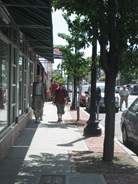Sidewalk Materials

Cambridge’s sidewalks are constructed of a mix of materials, primarily either concrete or brick. Of the two, brick is often seen as warmer, more attractive, and more historic. Concrete is generally seen as easier to maintain and easier to walk on.
The City must construct sidewalks that comply with the Americans with Disabilities Act (ADA), which states that ”surfaces of public sidewalks shall be stable, firm, and slip-resistant, and shall lie generally in a continuous plane with a minimum of surface warping.” To lessen unevenness and heaving, brick sidewalks are no longer made of molded brick set in stone dust, but are wire cut and laid over concrete. They are still somewhat uneven and can be slippery when wet, especially when covered with leaves.
While concrete sidewalks are easier for pedestrians and meet ADA specifications better, historical preservation concerns argue for the use of brick or, occasionally, bluestone in certain locations.
Asphalt has also been used for temporary repairs and where there is conflict with tree roots. While most people do not like the appearance of asphalt, it has proven to be the best material to prevent the trip hazards that tree roots can create.
Many sidewalks are now a patchwork of brick and concrete. Currently, when sidewalks are replaced on residential streets, City policy is to notify residents that the existing materials will be replaced unless the property owner informs the City otherwise. The City will change a brick sidewalk to concrete without charge but will not change from concrete to brick unless the abutter pays the additional cost.
For major streets, the City preference is for concrete sidewalks with a brick edge, which makes the sidewalks accessible and easy to maintain, while providing a decorative border.
The City continues to experiment with sidewalk materials and sidewalk and tree installation methods that promote tree growth.
For More Information
For more information please visit the Public Works Department.